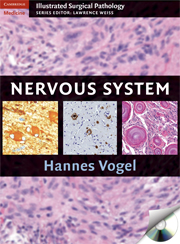Book contents
- Frontmatter
- Contents
- Contributors
- Preface
- Acknowledgments
- 1 Normal Anatomy and Histology of the CNS
- 2 Intraoperative Consultation
- 3 Brain Tumors
- 4 Vascular and Hemorrhagic Lesions
- 5 Infections of the CNS
- 6 Inflammatory Diseases
- 7 Surgical Neuropathology of Epilepsy
- 8 Cytopathology of Cerebrospinal Fluid
- Index
1 - Normal Anatomy and Histology of the CNS
Published online by Cambridge University Press: 04 August 2010
- Frontmatter
- Contents
- Contributors
- Preface
- Acknowledgments
- 1 Normal Anatomy and Histology of the CNS
- 2 Intraoperative Consultation
- 3 Brain Tumors
- 4 Vascular and Hemorrhagic Lesions
- 5 Infections of the CNS
- 6 Inflammatory Diseases
- 7 Surgical Neuropathology of Epilepsy
- 8 Cytopathology of Cerebrospinal Fluid
- Index
Summary
ANATOMY
Knowledge of nervous system anatomy is essential for success in surgical neuropathology. Familiarity with native cellular elements will often predict the appearances of diverse tumors within the brain but, perhaps more importantly, recognition of normal or reactive processes will help avoid the pitfall of diagnosing malignancy when, in fact, a nonneoplastic reactive process or even normal tissue is present. Many surgical neuropathology specimens originate in the brain and spinal cord coverings, cranial and spinal nerve roots, blood vessels, and bone and soft tissue surrounding the nervous system; thus recognition of the normal brain is not enough. As with general surgical pathology, knowledge of diseases common to these locations and the ages at which they typically occur is essential.
The human brain can be described in many ways. However, for the purpose of surgical neuropathology, this description will emphasize different surgical compartments and cytoarchitectural areas that are especially associated with tumors or other pathological processes (Figure 1.1). The central nervous system (CNS) is often divided into the supratentorial and infratentorial compartments by the dural tentorium, which separates the cerebral hemispheres from the brainstem and cerebellum. The spinal cord, roots, and distalmost cauda equina and filum terminale (Figure 1.2) are often considered separately, especially in view of the paraspinal soft tissue pathology, which can affect the integrity of the spinal cord.
Brain tissue is divided into gray and white matter. This distinction may be useful in the differential diagnosis of neoplasms, but is more important in other pathological processes such as infection or neurodegeneration. The surgical neuropathologist is often interested in the relation of a tumor to the ventricles, including the ventricular spaces themselves and their periventricular regions.
- Type
- Chapter
- Information
- Nervous System , pp. 1 - 19Publisher: Cambridge University PressPrint publication year: 2009

